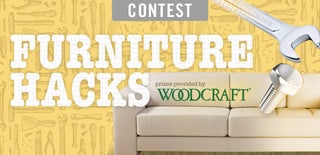Introduction: Production Turning Legs
As a cabinet maker, turning is not really a common skill in Australia. Fortunately its my hobby and I have the lathe, so I get given all the turning work for my job. Production turning I quite different to hobbyist turning as I found out. The emphasis is on the efficiency as well as accuracy for critical measurements. This is what I have learnt doing production turning for Parker style furniture.
Step 1: Set Up
You want your work space to be efficient. Easy access to everything, nothing in the way and room to move.
What tools you will need and where to keep them:
- Chisels and gouges. All I use to turn the buffet feet which is what ill be demonstrating is a 1 1/4 inch roughing gouge and a parting tool. I keep these behind the tail stock
- Working rod/template, pencil and ruler. Also these are best placed next to your tail stock. Seems alot but these take up little space
- Calipers. My spot for these, as seen in the pic, are hanging of the bed of the lathe with earth magnets. Right under the turning, easy to get and change sizes and not in the way. If they are, you can move them easily. I have 4 sets of calipers. This allows me to have multiple set ups so that I am not having to remeasure settings. Highly recommended to have at least 3
- Timber. This on the bed of my other lathe just behind me. Work bench near by is ideal. To increase efficiency, get your prep work done and mark your centers and punch them with the dead center before you start.
Step 2: Working Rod/template
This is my way of working accurately. It is a double sided jig that I have have made for most of my common orders for work. I use 3mm MDF to make these.
Side 1. Working rod. Standard, import jig to mark out positions of certain diameters. This is a straight edge with groves on the edge. Mark your diameters and the MDF and use the edge of the file to mark ground down a small grove for a pencil to just sit in. Label the groves to remind you of the correct diameters.
Side 2. Template. For simple shapes, this is easy to make. Draw the shape of the leg on this side. Cut it out with a band saw and sand it perfectly to your line. If this is out, all your legs will be too. They will be consistent of this
Step 3: Roughing
Mount your blank firmly between centers. Using the roughing gouge with long, even passes, reduce the blank to a round. Its easy for the gouge to vary depth of cut with an overhand grip. I use my index finger as a guide running that along the rest as a depth stop for an even cut. Also with a gouge like this, you can roll it a bit to cut on different parts of the edge. No point dulling only one spot.
Step 4: Marking Out and Setting Diameters
You hold the rod on the tool rest, 1mm from the timber (already rounded), flush to the ends. Your pencil drops in the grove and you can accurately mark the blank. The spinning blank gives a clean even line to work to.
Holding the parting tool in one hand and the calipers in the other you can get your diameters. As the parting tool cuts, the calipers will rub until the correct diameter is made where is will drop. This is when you stop cutting. You can do this with the lathe off if your are more comfortable with that. Make sure you are cutting to the side of the line with the smaller diameter. Otherwise you will cut into your good timber. Its an easy mistake.
Step 5: Using the Template
The template has the correct shape. When you hold it up the the turning it should flush up and you will have a perfect replica, providing your diameters are accurate. If you have a gap between your jig dont worry. Its easy to fix. The gaps are your low points. Where there is contact are your high points. (pic 1). To fix this, slowly remove the high points with your gouge until there are no gaps. Dont change the diameter of critical points (both ends)
Step 6: Sand
In basically every circumstance, the tool rest should be removed. I believe in a production circumstance there is a a safe way to keep your toolrest for all set ups. I know this could be controversial. Use a long piece and anchor your hand near the bango of the rest. Loosely hold the other side above the timber, hands no where near the rest. If it does grab, the paper will come out of the top hand, not putting yourself in danger. Go though the grits till you get your satisfied smoothness
Step 7: Videos
Here are some videos of me turning them for an idea o speed after i have got my eye in. The first ones are always a bit slower. You get more and more accurate the more you do.
Step 8: Complete Your Furniture
The templates can be made for many sizes and shapes.
Happy turning

Participated in the
Furniture Hacks Contest













